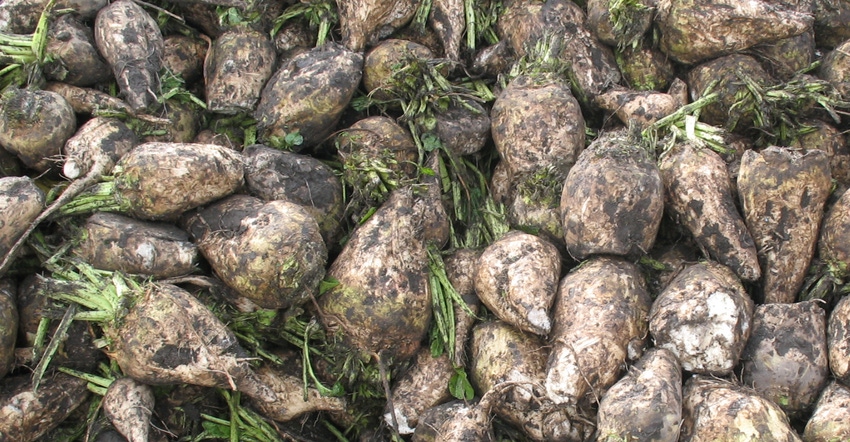December 5, 2019

By Karla Wilke
Temperatures dropping below 15 degrees F in early October may have put some sugarbeets in western Nebraska at risk of decaying at the crown. When decay begins in the beet before it can be processed, it makes the beet unacceptable for sugar production for human consumption.
In a University of Nebraska research trial with gestating cows, when 20% sugarbeets (dry matter basis) replaced 20% corn, cows performed similarly. When growing calves were fed 44% sugarbeets (dry matter basis), they were more efficient than calves receiving corn. In a finishing diet, however, when sugarbeets replaced corn up to 15%, cattle had reduced performance.
When sugarbeets begin to rot, sugars are lost rapidly. When rotting sugarbeets were analyzed for water soluble carbohydrates, they were found to contain only 26.9% compared with 73% in fresh chopped beets.
Fat soluble carbohydrates were 22.7% in rotting sugarbeets compared with 69.5% in fresh-chopped beets. Therefore, mixing chopped, rotting sugarbeets with straw or poor-quality hay as soon as possible will help reduce sugar loss. Mixing 10% poor-quality roughage and 90% sugarbeets on an "as is" or actual pounds basis, and packing in a bunker or ag bag, is a good way to reduce sugar loss.
The nutrient quality of chopped sugarbeets is different from that of sugarbeet pulp, which is the byproduct of sugar production. Sugarbeet pulp has a crude protein content of 10%, while sugarbeets will likely be 4.5%.
The neutral detergent fiber of sugarbeet pulp is about 45% and only 15% in sugarbeets, making the sugarbeet more of a comparable substitute for corn in the diet rather than a fiber source. A protein source such as distillers grains or alfalfa would need to be included in a diet with a mixture of poor quality-hay or residue and rotting sugarbeets.
The amount of sugar left in the rotting sugarbeet will vary, but assuming they have lost 10% of their original sugar and are mixed with residue or poor-quality hay in the proportions mentioned above, then the mixture could have a total digestible nutrients value of about 64%.
Sugarbeets not fit for human consumption can be an economical source of feed for beef cattle. For assistance developing diets containing chopped sugarbeets, contact University of Nebraska Extension personnel.
Wilke is a Nebraska Extension cow-calf systems and stocker management specialist.
Source: UNL BeefWatch, which is solely responsible for the information provided and is wholly owned by the source. Informa Business Media and all its subsidiaries are not responsible for any of the content contained in this information asset.
You May Also Like




